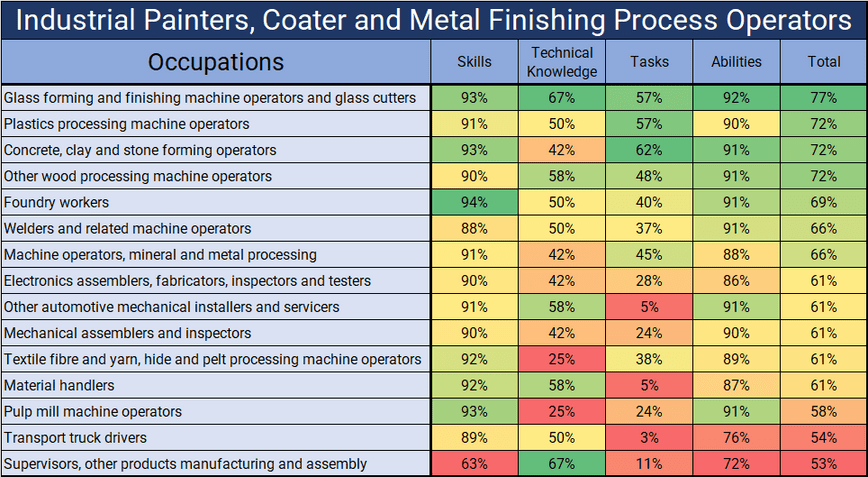Skills Transferability Matrix: Industrial Painters, Coater and Metal Finishing Process Operators
Painters, Coaters and Metal Finishing Process Operators perform unique key functions in manufacturing equipment and materials.
By working hands-on with machinery and equipment on a regular basis, they develop skills and abilities which are required for precise machine operation. The tasks they perform give them knowledge of procedures for material processing, lending to transferability in other aspects of manufacturing. Painters and coaters possess a standard set of industry tools, with some additional tools commonly seen in supervisory role.
Skills
Skills are developed through training and experience, and are the practical proficiencies someone possesses. The following are top key skills industrial painters, coaters and metal finishing process operators employ in their work:
- Monitoring
- Operation and Control
- Quality Control Analysis
- Time Management
- Coordination
Technical Knowledge
Technical Knowledge is the understanding of theory and utility of modern tools in a work environment. The following tools are used by industrial painters, coaters and metal finishing process operators regularly:
- Computer-aided design and manufacturing software
- Materials requirements planning logistics and supply chain software
- Industrial control software
- Time accounting software
- Facilities management software
Tasks
Tasks are the assigned duties that an occupational group performs in their daily work. The following are the tasks industrial painters, coaters and metal finishing process operators most regularly encounter:
- Immerse objects or workpieces in cleaning or coating solutions.
- Adjust flow of electricity to tools or production equipment.
- Inspect finishes of workpieces or finished products.
- Mount attachments or tools onto production equipment.
- Monitor equipment operation to ensure that products are not flawed.
Abilities
Abilities refer to the innate faculties that allow workers to carry out tasks and activities. The following are the top abilities that industrial painters, coaters and metal finishing process operator possess:
- Control Precision
- Arm-Hand Steadiness
- Visual Colour Discrimination
- Near Vision
- Manual Dexterity
Skills Transferability Matrix
FOCAL’s Skills Transferability Matrices analyze the transferability of an occupation across a multitude of other occupations on the basis of similarities in skills, technical knowledge, tasks, and abilities as outlined by the O*Net database. It aims to show workers how to leverage their skill set in changing occupations, planning a career path, and transitioning to other industries. It also assists policy makers and educators address changing skill sets and areas of opportunity for workforce entrants in developing industries. Employers can also use this tool in reskilling or upskilling workers to circumvent skills shortages, and reduce the hiring and training challenges

After scanning over 2,600 skills, technical competencies, tasks, and abilities of each of the 500 occupations as defined by the National Occupational Classification (NOC) system, a skills transferability matrix for industrial painters, coaters and metal finishing process operators is produced. In the matrix above, a high score is highlighted in green and indicates the high transferability potential of an attribute of an occupation with that of painters, coater and metal finishers. Lower or no transferability areas are marked in red. Painters, coaters and metal finishers exhibit a high transferability in the abilities and skills attributes to machine operations roles, which may be the result of regularly exercising desirable traits such as control precision and operations monitoring. An overlap can also be found in the attributes of assembly, inspecting and testing roles in manufacturing. Painters, coaters and metal finishers also display a high aptitude in technical knowledge that is required for supervisory roles, particularly for manufacturing and assembly, and with appropriate training may be able to transition into those roles.
To learn more about developments, trends and new technologies in Canada’s automotive manufacturing industry, visit our website futureautolabourforce.ca. You can also check our social media by following these links: LinkedIn, Facebook, Twitter and Instagram.

